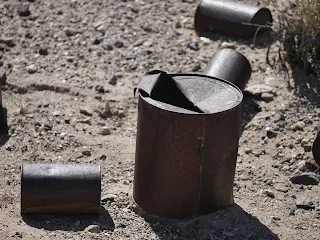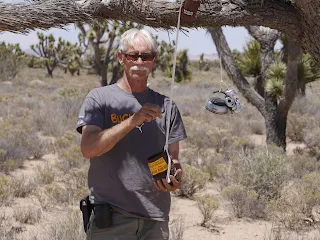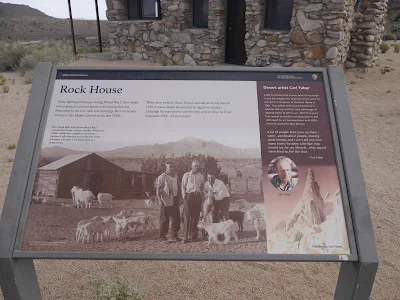According to Laura Hammonds, the executive director of the Mojave Desert Heritage and Cultural Association, (that is one long title, she has), nearly 3,000 people visit the center each year in Goffs.
Hmmm, what is Goffs? Anyone driving east or west along Highway 40 knows the turn off for Goffs Road. It’s that exit with a certain gas station, won’t say the name but it charges a wee bit higher price for gas than anywhere else. That’s okay – capitalism works and supply and demand is the root of capitalism. But here’s a thought – check your gas gauge before leaving Barstow or Needles. You may be able to afford your kids’ college if you do. Now, I’m a financial whiz.
Back to Goffs.
Goffs, like many of the small towns or villages along Route 66, has an interesting history. And like many, the towns or villages are now non-existent, or very small when it comes to the number of humans living there.
“I’d say, that there are probably ten fulltime residents and maybe twenty-five during peak times,” Laura stated.
Must be very quiet in the desert at night, miles away from the rumble of Highway 40 to the south. Really quiet.
“You can hear a bat flapping its wings while it flies over the Piute Mountains, it’s so quiet here.” That wasn’t really a quote from Laura. I made it up, as I sometimes do – but it must be pretty silent at night – except for one thing:
The railroad that is literally in the town itself.
“The Burlington Northern Santa Fe Railroad Goffs crossing is here. The train crosses Route 66 right here at Goffs,” Laura told me. Yes, that’s a real statement, and not one I made up.
That wonderful creation, the railroad which brings us so many of the things we need to make life bearable, sweeps through Goffs at all hours of the day and night, tooting its horn. Things like medicine, food staples, stuff we buy that we don’t really need, and personal hygiene supplies like toilet paper – yes, toilet paper.
No one will forget the year 2020 – when it wasn’t unusual to see people stop at traffic lights, roll down their windows and ask the driver in another vehicle – Pardon me, but do you happen to have Charmin Ultra-Soft?
Goffs was originally named, Blake, in 1893 after Isaac Blake, who was the builder of the Nevada Southern Railway. That name was later changed to the California Eastern Railway and that was changed to something else even later on and that changed to something else still later. Seems, as with so many things in life, change is inevitable. And so it is with names of railroads. Today, it is the Santa Fe Railroad for short, and so far that name has stuck. But, who knows what tomorrow may bring? And a rose by any other name…
And the research is not conclusive as to where the name for Goffs name actually originated, but the railroad was using names in an alphabetical way for stops along the tracks. Let’s call this one Goffs? Have no idea why, but won’t it be fun a long time from now having people guessing its origin? There you go, future folks!
My lovely spouse, Laureen, likes to think that Goffs was named after the author Helen Lyndon Goff, who wrote the magical nanny story, Mary Poppins, under the pen name P. L. Tavers. And she says I have an imagination. But who knows?
The history of Goffs goes way back, to when this area saw the likes of Francisco Garces, the first non-native in 1776. The Spanish friar and explorer was looking for an easy passage east and west through the Mojave Desert and spent considerable time not far from present day Goffs.
In fact, Garces desert route is what we know today as the Mojave Road – that stretch of isolation on which off-roaders love to spend time. I drove that stretch a few years back, in the summer, of course, with only one vehicle, of course – and lived to tell about it. Thanks Friar Garces – in my heart, he’s a saint for watching over not the brightest of desert travelers.
Then the adventurer, Jedediah Smith came through the area twice, once in 1826 and again in 1827, also looking for a route through the oftentimes difficult desert terrain. On one of those adventures, it is believed that Smith was running for his life from the direction of the Colorado River, chased by a group of angry natives. I wasn’t there, but it is a good story all the same.
Goffs played an important role delivering water for the steam engines on the main line to Barstow. Situated only thirty miles from Needles made this location – at the top of the hill – to be the ideal watering stop for trains. By 1911, there were enough Santa Fe workers and their families to warrant the building of a school house, which was built in 1914.
The school house still stands, and can be visited on the museum grounds, run by the MDHCA – Mojave Desert Heritage and Cultural Association. Along with the school house, there are many exhibits detailing the history of this once thriving town on Route 66.
Goffs school house - no longer used as a schoolLike any town along the route, simple paths became wagon trails, then railroad lines and eventually the dirt paths along those railroad lines were paved. And, there you have a road for that contraption called a car.
The United States Army built a training center in the area during WWII called Camp Goffs. It served its purpose until 1944.
According to Laura, “Because of the availability of water and good rail service an entire division was here at Goffs at one time. People can still find military artifacts throughout the Goffs area.”
Camp Goffs in the 1940'sWe all love finding trinkets on our adventures, but if you come across a rusty pointed munitions thingy – please leave it alone. A military button, belt buckle or an abandoned tank, okay – a bomb, not so much.
“Everything that happened in the West, happened here. Mining, homesteading, cattle ranching, railroad, and Route 66. It all happened in Lanfair Valley,” stated Laura.
Yes, Goffs is located in Lanfair Valley. According to Wikipedia, Lanfair Valley is drained southeastwards, then due south by the Sacramento Wash, which then turns due-east and combines with the Piute Wash drainage. The dual valley drainage is a U-shape, and the first major dry wash drainage from the west, into the Colorado River, south of Lake Mead.
I have no idea what that means exactly, but the area sure is pretty.
Goffs’ largest building, the general store, is abandoned but still standing – unfortunately it has been vandalized and graffitified – I made that word up, but looks like it should be entered into Merriam Webster’s book.
The once thriving community market in GoffsGoffs is definitely worth a visit. The museum opens in October, which is a wonderful time of year to visit anything in the desert. When did we visit? The summer – who’d think that?
Story first appeared in the Daily Press under - Beyer's Byways


















































